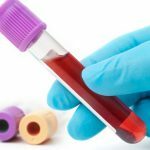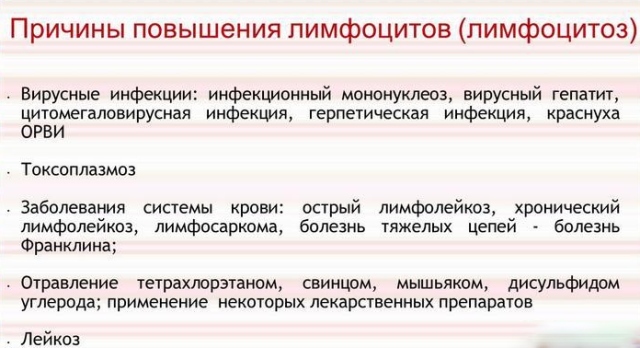Lymphocytes are a variety of leukocytes responsible for cellular and humoral immunity, and they also counteract the development of malignant tumors. Often they are called "memory cells", "helpers" etc. Once they met with a pathogen, they can store information about it in their blood for the rest of their lives, so immunity works. The normal indices of these cells vary widely. Therefore, the deviation from the permissible boundaries is significant for the organism and indicates in most cases a serious pathology. Whether it is possible to hand over analyzes of a blood, including on lymphocytes, at monthly? Will this lead to a deliberately misinterpretation of the result?
Lymphocytes are important blood cells
Lymphocytes are formed in the most part in the thymus( thymus gland), bone marrow, as well as in the lymph nodes, spleen, some intestinal structures.
There are three main varieties:
- T cells. They provide cellular immunity. There are many varieties of this group: helpers, suppressors, killers, etc. The names reflect their basic functions. Figuratively, when a pathogen appears, some cells signal others about "strangers", the next batch arrives and destroys, or is reported by some other. And so there is a whole chain of interconnections. Like this process, all body cells are recognized. Simply put, part of the T-lymphocytes are constantly circulating around the body, identifying the cells as "their own and others'."In case of failures, the human cells of the human body are regarded as pathogenic. So there are autoimmune diseases.
- B cells. Provide humoral immunity. They act through "intermediaries" - immunoglobulins. For each stage of the inflammatory response is characterized by an increase in those or other fractions. As a result, having determined the level of immunoglobulins, one can judge whether the organism ever met this pathology. So Ig G indicates the infectious pathology, Ig M - for the acute period of the disease, Ig A - for subacute and the like. All of them are also called antibodies in general. When carrying out the vaccination, the doctor targets the immunity to create precisely these "memory cells" in relation to a particular pathology. Then, when a truly pathogenic agent enters the body, the response to it is already clear and directional.
- NK cells. These are the "guards" for the development of malignant tumors. When they detect abnormal cells in the human body, they immediately destroy them. If this link is defective, there is an uncontrolled growth of oncological pathologies.
The lifespan of lymphocytes can vary from a few minutes to dozens of years. It all depends on their function. Thus, the cells responsible for storing information are active during almost the whole life of a person. And T-killers, for example, when encountering a pathogen, may die at the same moment. That is why the norm limits for lymphocytes are wide enough.
Normal indices
The limits of permissible values of lymphocytes are quite large.

The following values are considered optimal:
- in relative figures - 18 - 40%,
- in absolute - 0,8 - 4 * 109 / l.
If percentages change, they talk about relative lymphocytosis and lymphopenia, if the number of cells is absolute.
The boundaries for children differ from those of adults. There are also physiological changes in these indicators in pregnant women. Normally, several elevated lymphocytes can be detected with monthly, which should not be particularly embarrassing.
What will the deviation from
tell about?Changes in the number of lymphocytes may indicate an organism's response to some changes in the environment or its own organism. Most often, abnormalities are observed in various diseases, but a slight increase or decrease in the level may be normal under certain conditions.
Enhancement of
Lymphocytosis is less dangerous than reducing the amount of these blood elements. Physiological increase can be observed in the following conditions:
- after intensive sunbathing in the salon or on the beach;
- after consuming a significant amount of alcohol and fatty foods, which often happens after all kinds of feasts;
- after intense sports training;
- in the period of stressful situations and psychoemotional loads;
- during the gestation period, the norm limits are also higher than usual( the detection of a large number of lymphocytes in the peripheral blood of pregnant women is due to the general decrease in immunity required for the normal development of a half-foreign child for a child in the genetic material);
- in heavy smokers is also found lymphocytosis, which is associated with an increased reaction of the body to regularly entering the lungs of tar and other harmful substances;
- lymphocytes before the monthly, during and immediately after the critical days can also be slightly increased, due to changes in the uterine cavity.

Infectious pathology
If neutrophils( a group of white blood cells) are responsible for ingesting pathogenic bacteria, then the lymphocytes take full responsibility for the viral invasion. They destroy the "strangers", form a "memory" for many years in relation to them. Therefore, their absolute increase is an indisputable sign of the presence of a viral infection. Most often you have to face the following diseases with characteristic lymphocytosis:
- mononucleosis,
- rubella,
- chickenpox,
- measles,
- whooping cough,
- mumps,
- adenovirus,
- ARVI and influenza.
Most of these pathologies are vaccinated even in childhood, so the risk group is those who for some reason did not undergo these procedures at a young age.
Lymphocytosis is also observed with syphilis, tuberculosis, malaria, diphtheria, typhoid fever and some other pathologies.
Malignant tumors
In girls after 14-16 years, chronic lymphocytic leukemia and various hyperplastic processes of lymphoid tissue lead to lymphocytosis in girls. For a while, these diseases can occur almost without symptoms.
Chronic lymphocytic leukemia is characterized by the fact that lymphocytes are formed and pass through all their stages of differentiation, but for some reason they can not perform their functions. As a result, the body tries to compensate for the defect of immunity by a constant increase in their number, but, as a rule, to no avail.
Chronic lymphatic leukemia is characterized by an increase in many groups of lymph nodes, the appearance of unmotivated weakness, lethargy, increased fatigue. Due to the inferiority of immunity, a variety of viral diseases constantly occur, often with a severe course. The blood clotting ability may be impaired, the liver and spleen increases.
The clinical picture of hyperplastic processes of lymphoid tissue is similar, but these diseases are more difficult to diagnose, and they are much less common.
Autoimmune pathology
With certain malfunctions, own tissues are perceived by lymphocytes as dangerous. As a result, the organs begin to break down by their own cells. Accordingly, the number of lymphocytes responsible for this process increases in the blood.
Most often, autoimmune thyroiditis develops - the pathology of the thyroid gland. In addition to changes in hormones, a specific ultrasound picture, there is lymphocytosis of the blood. Also, similar changes can be seen with rheumatoid arthritis, Crohn's disease and other pathologies. The index of lymphocytes at monthly, after or on the eve of them will not differ, always proving to be above the norm in these diseases.
Drug poisoning
When ingested, some heavy metals and medications can cause a decrease in the number of neutrophils. As a result, relative lymphocytosis is formed at normal absolute values.
After the removal of the spleen
, the spleen is involved not only in the formation of lymphocytes, but this is also the place where their destruction occurs. When removing the organ for some reason( after an injury or as a result of a disease), the blood cells have to look for another place. As a result, most of the lymphocytes circulate in the blood longer than usual, as would be the case in the normal process of their formation. And an increased number of them is formed. Over time, there are compensatory changes, and lymphocytes come back to normal.
Reduction of
If the number of these blood cells is determined below 1.0 * 109 / L, this condition is always very alarming and conceals a serious pathological condition in 99% of cases.
Infectious pathology
If the inflammatory process takes place in the body for a long time, it does not lend itself to medical therapy, at some point the protective forces exhaust, the quantity of blood lymphocytes decreases. In the absence of proper treatment, sepsis can develop with a severe, sometimes fatal, outcome.
Pathology of bone marrow
Bone marrow is the place of formation of lymphocytes and other blood cells. If the pathological effect on it, this process can be violated, as a result, the number of uniform elements of blood decreases.
Similar conditions may occur against the background of radiation exposure, with long-term use of certain medicines, for example, cytostatics.
Oncological diseases
Some malignant pathology is also characterized by a decrease in the number of lymphocytes. For example, Hodgkin's lymphoma. In this case, against the background of an enlarged group of lymph nodes there is weakness, fatigue, fatigue. Anemia and other pathological conditions develop. For a long time the disease can go on barely noticeable, but with careful examination it is always possible to detect abnormalities.
Immunodeficiency states of
All immunodeficiencies, congenital or acquired, are characterized by lymphopenia. It is not always possible to identify pathology in time. The main sign of immunodeficiency is a constant viral and bacterial infections.
For example, HIV belongs to this group. This disease disrupts the work in the main T-cell link. The higher the stage, the brighter the clinical manifestations. Eventually even bacteria that normally live in the human body begin to cause pathological processes.
Is it worth to take an analysis with monthly?
Can lymphocytes be raised at monthly intervals, and when is it better to take a blood test? Yes, indeed, on the eve of critical days and during them, the changes taking place in the endometrium cause some changes in the blood test. Aseptic inflammation( a special kind without involvement of pathogenic microorganisms) leads to an increase in the level of lymphocytes. Sometimes the indicator is at the level of 50 - 55%.
Therefore, in controversial situations or for the purpose of controlling the disease, blood should be donated for 7 to 14 days of the menstrual cycle.
 We recommend reading the article about the analyzes during the monthly. From it you will learn about giving blood during menstruation, when you can take the test, and when you can not, as well as on the delivery of urine tests and ultrasound.
We recommend reading the article about the analyzes during the monthly. From it you will learn about giving blood during menstruation, when you can take the test, and when you can not, as well as on the delivery of urine tests and ultrasound.
But it should be understood that changes in lymphocytes are not at all and not always. Therefore, in case of emergency it is possible to take tests at any convenient time. With any deviation, you can simply do everything again.
Lymphocytes are the "guards" of immunity in the human body. Significant deviations in this or that side in most cases testify to some pathology. Of course, there is the influence of monthly on lymphocytes, pregnancy and some other conditions, but only the doctor will be able to figure out definitively the indices.


